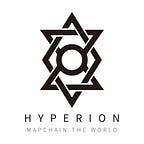Hyperion Map3 Conference Keynote Speech Part2 — Isaac Zhang
Spatial structure
As I’m about to talk spatial structure, I’d like to share a phrase with you, which I think will best summarize the core idea of today’s part — the highest bidder wins. The richer with higher purchasing power own more resources to exchange their desires. In fact, the discipline applies to the entire market. For instance, companies are usually born from the seizure of maximum resources at production level.
The essence is that key resource keeps the market order. Under a spatial structure, a more capable employee tends to take higher responsibility and get better reward. In addition, a more efficient spatial structure should grow in complexity as the system grows.
Secondly, an ecosystem should reasonably allocate resources and reward participants periodically, rather than one-off speculators flood into the bull market. Therefore, a spatial structure will generate sustainability as compared to pure temporal structure, with a sophisticated design.
Two points to mention here. First, both temporal and spatial structure requires key indicators. In case of BTC, halving period determines mining difficulty. Similarly, spatial structure needs a verifiable indicator to take progressive measures periodically.
A spatial-temporal structure is key to remain demographic dividend within the network, which is essential to the emergent new infrastructure development, as it requests an equal community structure with attractive rewarding mechanism.
As you design a self-growth engine to achieve network effects at the application level based on consensus and temporal-spatial structure, rather than attract new entrants with economic incentives, the size of contributors and the value they generate out of work will double. This is known as the Internet network effect. For example, when Uber reaches certain user scalability, it no longer needs to attract new comers with subsidies.
In market economy, the visible hand at micro-economic level and the invisible hand formed regular growth cycles throughout historical period. In comparison, an inefficient token economy is manipulated by a black hand that creates market risks throughout token circulation, lock-down and issuance. While a highly-efficient token economy will remain demographic dividend within the ecosystem with the “two hands”. The difference is, community will act as the visible hand to supervise and run the ecosystem instead of governments or institutions.
While the invisible hand is an ecological indicator. For instance, the indicator of BTC is temporal — the halving period. Similarly, spatial structure requests a verifiable indicator to lead and observe the growth of ecosystem. In addition, the ecological progress should be predictable community participants. Last but not the least, the governance of community is closely linked with organizational structure. As in a company, stakeholders and CEOs share different interests and goals, a healthy blockchain community structure aims to boost mutual-cooperation and balance mutual profits between early and late participants to attract more contributors.
Within the concept of 1+2 to 3+x, the first invariant indicates the lowered transaction fee in blockchain as compared with new infrastructure, especially in fields with higher systematic costs. For instance, BTC transaction reduces auditing and supervision fee. The second invariant is the increased demographic dividend created by community consensus. Consensus means smart contracts will enable the transparency in transaction supervision and governance on-chain. Hyperion therefore designed a three-tier temporal-spatial structure from three layers — Titan, Map3 to Atlas Chain based on the PoH consensus mechanism, to encourage the participation of location blockchain projects and individual contributors.
With the hybrid mechanism of PoW * PoS, participants will be more engaged with the ecosystem as it grows. In return, contributors will be economically rewarded. In addition, Hyperion designed a burning mechanism on existing HYN tokens, to grow the network value with increasing user rewards through token scarcity. Therefore, the temporal-spatial structure adopts two-tier staking mechanism based on three-tier structure, to reward different players at various engagement level. Overall, a hybrid consensus mechanism will benefit all contributors along the progressive network.
The 1+2=3 equation aims to help you understand the design structure easier. 1 indicates a decreased transaction fee, 2 equals the PoW*PoS hybrid consensus mechanism that motivates the network growth at two dimensions of indicators — temporal and spatial. 3 is the self-adjustable algorithm.
The index P indicates the maturity of ecosystem, which is closely related with the burning of tokens. The burning mechanism uses self-adjustable and publicly verifiable data to demonstrate the growth of the ecosystem, and burning mechanism + PoH consensus enable the co-governance of stakeholders while balancing individual reward to achieve sustainability. X means anything that is possible, which links to our plan to launch an HRC contract standard to empower future blockchain projects like ERC20.
You might have never heard of transaction structure. For instance, staking a BTC in exchange for USDTs is a type of transaction structure for staking, but with a programmable mechanism to minimize the transaction fee in settlement.
Secondly, a programmable temporal-spatial architecture optimizes the allocation of resources as the participants grow. For example, the new user you bring to Facebook will increase the company value, however, you get nothing out of Facebook since it regards you as an outsider. For Internet companies, the profit allocation is calculated internally/off-chain, while blockchain will put the rewarding system on-chain according to a transparent transaction structure.
Last but not the least, token mechanism determines the issuance, lock-down and recycle of HYN token, and Hyperion allows community stakeholders to manage the transactions with smart contracts, which in return reduces the potential systematic risks.
Thank you!
